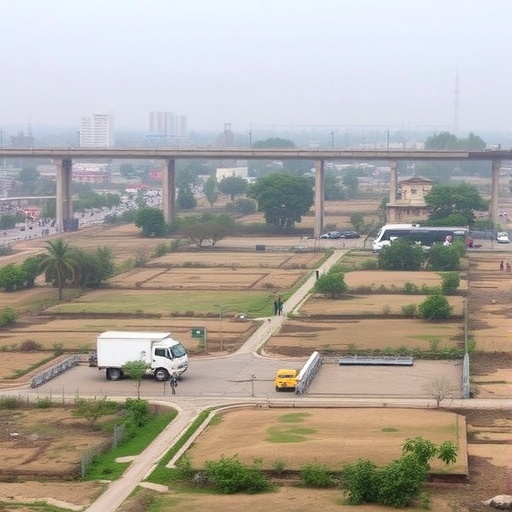Water scarcity is becoming an increasingly pressing global issue, especially in the context of rapid urban growth and climate change. Cities around the world are witnessing a dramatic rise in the demand for water, which has outstripped the supply capabilities of rivers and reservoirs. The heavy reliance on groundwater has led to severe depletion of these underground resources, causing land subsidence—a phenomenon where the ground sinks due to the removal of water from aquifers. This alarming reality has significant implications for urban infrastructure, particularly in densely populated countries like India.
A recent study highlights how land subsidence poses a serious threat to the structural integrity of buildings in major Indian cities. Researchers focused on India’s megacities, including New Delhi, Mumbai, and Chennai, where rapid urbanization has intensified the extraction of groundwater, ultimately destabilizing the land. The study indicates that more than 2,400 buildings are currently at high risk of damage due to the gradual sinking of the ground beneath them.
One of the key findings of this research indicates that approximately 878 square kilometers across these megacities is undergoing subsidence. This calls attention not only to the immediate physical risks that residents face but also to the long-term implications for urban planning and infrastructure resilience. As groundwater extraction continues unabated, the land is sinking by several millimeters each year, which may seem negligible but has severe repercussions when combined with extreme weather events, such as storms and flooding.
The research was expertly led by Dr. Manoochehr Shirzaei, a significant figure in the study of Earth sciences and an advocate for utilizing technology and research to combat these environmental challenges. According to Dr. Shirzaei, the subsiding land is a direct response to the pressure inflicted by human activities on both the Earth’s surface and subsurface systems. As urban development pushes into more ecologically fragile areas, the infrastructure becomes increasingly vulnerable, presenting a stark challenge for city planners.
Population growth in urban areas exacerbates the problem of groundwater depletion. As cities expand rapidly, the natural recharge of aquifers becomes severely restricted, leading to a dangerous cycle of depletion and subsidence. The study estimates that up to 1.9 million people live in regions experiencing a sinking rate greater than 4 millimeters annually—a measure indicating a significant risk for future structural failures.
Increasing awareness about these perilous trends is vital. As Professor Kaveh Madani states, the damage to groundwater resources is often “invisible and unnoticed” until it translates into tangible risks such as property damage or, in worst-case scenarios, loss of life. The underground water supply is often overlooked in discussions of water management, yet its significance cannot be understated. This research pushes for urgent action to avoid irreversible damage to these hidden resources.
Mitigating the impact of subsidence will require a multifaceted approach. The authors of the study advocate for a combination of strategies focused on sustainability. These strategies include improving surface water management, reducing groundwater extraction, promoting natural methods for groundwater recharge, and investing in the conservation of soil and vegetation. By adopting a more holistic view of urban water management, cities can better prepare for the implications of land subsidence.
Urban resilience in the face of climate change is critical, and no strategy can afford to ignore the socio-economic implications for the affected populations. The continuing crisis of water scarcity is not just an environmental concern; it is inherently intertwined with issues of public health, socioeconomic stability, and community resilience. Sustainable practices that protect groundwater not only benefit the environment but also preserve the built environment for generations to come.
Experts urge city planners and policymakers to integrate findings from such studies into their frameworks for urban development. By emphasizing research into groundwater management and its consequences on urban infrastructure, cities can take a proactive stance on this issue instead of a reactive one. If action is not taken, projections indicate that if current subsidence rates persist, the risk of structural damage could extend to over 23,000 buildings within the next 50 years across India’s five megacities.
As evidence mounts regarding the challenges posed by subsidence due to groundwater depletion, media attention on this subject can stimulate broader discussions within communities. Educating the public on the importance of sustainable water management practices can drive grassroots initiatives aimed at conservation and responsible usage.
The study offered critical insights and serves as a clarion call to cities not just in India but worldwide to reassess their water management practices. With proper policy responses, technology innovations, and public engagement, urban areas can mitigate the risks of subsidence. As more cities face similar challenges in different parts of the globe, this research points to what may become a shared plight of urban centers worldwide.
In conclusion, water management is on the precipice of becoming one of the primary challenges facing urban planners in the 21st century. In context, the ongoing struggle against land subsidence emphasizes the need for communities to engage in proactive water conservation measures. Understanding the gravitational forces affecting urban infrastructures will be crucial in navigating the approaches needed to forge sustainable, resilient cities.
With unpredictable climate patterns and unprecedented urban growth, how cities respond to the crisis of groundwater depletion will determine not only their future stability but also the safety and welfare of their inhabitants. The future of urban life in India and across the world will hinge on recognizing the interconnectedness of resources and the actions taken to safeguard them.
Subject of Research: The impact of groundwater depletion on land subsidence and the risks to urban infrastructure.
Article Title: Building Damage Risk in Sinking Indian Megacities
News Publication Date: 28 October 2025
Web References: Nature Sustainability
References: Sadhasivam, N., Ohenhen, L., Khorrami, M., Werth, S., & Shirzaei, M. (2025). Building damage risk in sinking Indian megacities. Nature Sustainability. DOI: 10.1038/s41893-025-01663-0.
Image Credits: Not provided in the text.
Keywords
Groundwater, Urban Resilience, Land Subsidence, Water Management, Climate Change, Infrastructure Stability.




